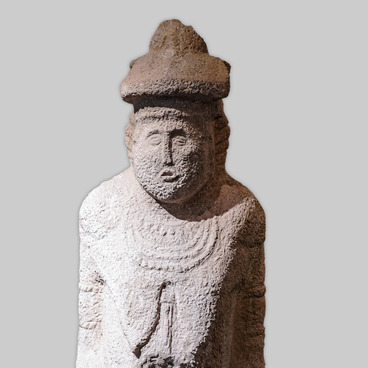The exhibition of the Museum of the History of Tatar Statehood and the Republic of Tatarstan contains a battering cannon ball made of limestone, which dates back to the second half of the 16th century. It was used during the assaulting of Kazan by the troops of Tsar Ivan IV Vasilyevich in 1552.
The stone cannon ball is an early type of artillery projectile that was used for firing from throwing machines, and later from bombards and other powder cannons. Until the end of the 15th century, cannon balls were made from limestone, and then, due to the spread of cast iron, they began to be gradually replaced by metal ammunition.
The cannon balls were spherical projectiles that were hollowed out of stone. Sometimes two iron hoops were placed on them crosswise. With their help, they destroyed fortifications, hit a live target and threw various harmful ammunition into enemy territory.
In the cultural deposits of the Kazan Kremlin, a layer of the fire of 1552 was discovered, which with a black line delimited the period of Khan’s Kazan from the subsequent ones. Numerous stone cannon balls that were found during excavations in the central part of Kazan were traces of the assault. The number of cannon bullets and arrowheads indicated that the fights were long and intense. Over the years of archaeological excavations on the territory of the Kremlin, researchers have collected a large collection of various cannon balls from limestone, granite and iron.
The limestone cannon balls were divided into two large groups, depending on their size. One type of gun had a diameter of 50–60 centimetres, and the other 25–30 centimetres. The diameter of the granite cannon balls was 13–15 centimetres, and the iron cannon balls were 8–12 centimetres. Incendiary cannon balls were made of clay: inside them there were cavities into which a flammable liquid was poured, and holes for wicks were placed on top. The diameters of these cannon balls don’t exceed 9–12 centimetres. Such shells were found in many settlements of the era of the Golden Horde and the Kazan Khanate.
Most of the cannon balls of the Kazan Kremlin were found in the archaeological layer that reflected the assault on Kazan in October 1552.
The stone cannon ball is an early type of artillery projectile that was used for firing from throwing machines, and later from bombards and other powder cannons. Until the end of the 15th century, cannon balls were made from limestone, and then, due to the spread of cast iron, they began to be gradually replaced by metal ammunition.
The cannon balls were spherical projectiles that were hollowed out of stone. Sometimes two iron hoops were placed on them crosswise. With their help, they destroyed fortifications, hit a live target and threw various harmful ammunition into enemy territory.
In the cultural deposits of the Kazan Kremlin, a layer of the fire of 1552 was discovered, which with a black line delimited the period of Khan’s Kazan from the subsequent ones. Numerous stone cannon balls that were found during excavations in the central part of Kazan were traces of the assault. The number of cannon bullets and arrowheads indicated that the fights were long and intense. Over the years of archaeological excavations on the territory of the Kremlin, researchers have collected a large collection of various cannon balls from limestone, granite and iron.
The limestone cannon balls were divided into two large groups, depending on their size. One type of gun had a diameter of 50–60 centimetres, and the other 25–30 centimetres. The diameter of the granite cannon balls was 13–15 centimetres, and the iron cannon balls were 8–12 centimetres. Incendiary cannon balls were made of clay: inside them there were cavities into which a flammable liquid was poured, and holes for wicks were placed on top. The diameters of these cannon balls don’t exceed 9–12 centimetres. Such shells were found in many settlements of the era of the Golden Horde and the Kazan Khanate.
Most of the cannon balls of the Kazan Kremlin were found in the archaeological layer that reflected the assault on Kazan in October 1552.


